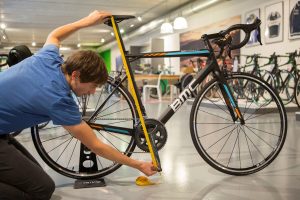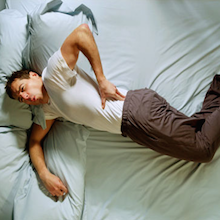During this unprecedented time, it is still very important for us to stay as active as possible. All of us are looking for various types of exercises to accomplish our exercise goals. It may be a garage gym, picking up running or dusting off the old bicycle. We need to be careful if we are starting a new activity to avoid injury. The best way to avoid injury is to try to prevent them in the first place. Today I wanted to address those of you who have recently picked up biking to fill this void. It doesn’t matter if you pulled out an old bike from Wal-Mart or you just bought the state-of-the-art Peloton bike. How you set up the fit of your bike is going to be a huge factor in preventing injury.

I wanted to go over the basics of how to properly set up your bike by putting your body in the best position to avoid injury. This is meant to be the 1000-foot view of this process and once COVID-19 ends nothing will beat going to your local bike shop for a proper fitting.
Foot Position– This position is going to vary greatly. If you have a bike with cleats this section is going to be very important or if you have pedals that don’t strap your feet down this will just give you general guidelines to follow.
- Toe position (position where the pedal makes contact on your foot)- this determines all the power coming from your ankle and research shows that less than 5% of your power comes from your ankle so typically it’s recommended putting the position of the pedal on the foot as far back towards the heel as your shoe allows which will require the least about of ankle mobility
- Foot Rotation (the degree to which your toes face straight forward)- this depends on your lower extremity alignment and your personal anatomy. Ideally you are able to go to an expert to help determine this but that most likely is unavailable at this time. To help determine this yourself you can use a squat test. For this test you perform an air squat multiple times each time adjusting how much your toes are turned out, depending on which positioning is most comfortable for you will determine your foot position on the bike. If squatting with your toes turned out is more comfortable then try some toe out positioning on the bike. Conversely if you feel more comfortable with your feet straight ahead again assume the straighter position on your bike
- Foot Width (how wide your feet are on the pedals)- this depends on your hips; you want your foot to be directly underneath your hips. Place your feet on the pedal so your footfalls directly underneath your hip. Some research shows the narrower the alignment the more efficient economy so error on being more narrow
Seat Adjustments
- Seat Height
- Seat height is measured with you sitting on your seat with one foot on the pedal. The pedal (crank arm) position should be pointing towards the ground roughly parallel with the seat tube. While sitting on the seat in this position your knee should be flexed anywhere between 25-40 deg. As long as you’re within this ROM you can base your placement on comfort. Keep in mind if you have a history of anterior knee pain (pain on the front side of your knee) you want to have your knee closer to being straight.
- Seat Fore/Aft (how far forward or backward your seat is set)
- This is measured by looking at the knee while your crankshaft is in the forward position. Then you will look at where the knee falls in line with the pedal spindle. The knee cap should be in front of the pedal spindle and the fibular head (bony prominence on the outside of the knee) should not be past the pedal spindle. As long as your knee falls inside this range you can base the positioning on comfort. One thing to keep in mind is the further back you seat is the more hip flexion demand, so if you have any hip flexion issues you may want to position your seat in a more forward position.
Bar Position
- This should be that last adjustment, you should adjust your seat prior to this step.
- Bar Drop refers to how much lower your handlebars are below your seat. The one thing to keep in mind is if your average speed is below 25 mph while riding your bike, the aerodynamics don’t have a significant factor, so base this on comfort.
- Fore/Aft (how far forward or backward)- The shoulders should be around 90 deg angle.
- Width (how far your hands are apart) – wider is better for breathing and handling, narrow is more aero, so the balance between the two and base decision on comfort. Remember if your average speed is below 25 mph, aerodynamics isn’t making a significant difference.
That is the 1000-foot view of bike fitting and should help you reduce your risk of injury. This process can get far more detailed to fit your bike to your specific anatomy. Your local bike shop can be an excellent resource to get a detailed fitting. During this time where you may not have access to the bike shop or may have other injury questions please feel free to contact us at ProFlex Physical Therapy!!



